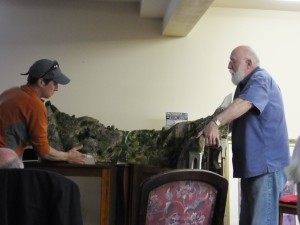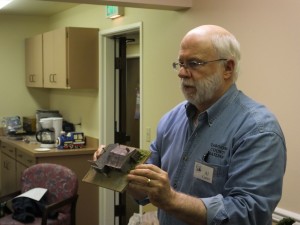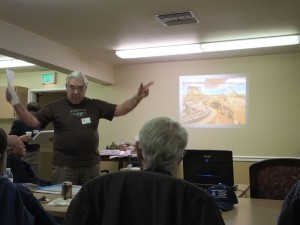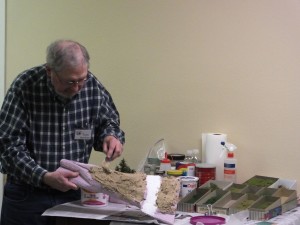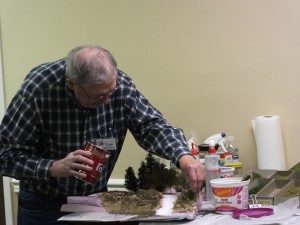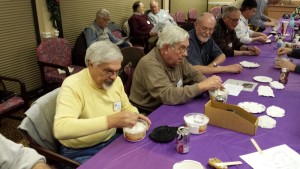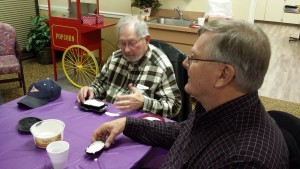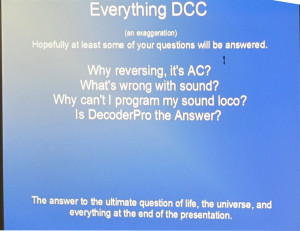The Mount Vernon Clinic scheduled for Monday, December 19, 2022 has been cancelled due to extreme cold, slippery road conditions and more snow in the forecast. Hopefully the clinic will return to our regular 3rd Monday schedule in January, 2023. – Al Carter, Temporary Clinic Chairperson
You are browsing archives for
Author: Alan Carter
Mount Vernon Clinic is Monday, Oct 17, 7pm
October 17th is the next Mount Vernon Clinic, starting at 7:00pm at the Mount Vernon Senior Center, 1401 Cleveland Street. Entry is through up the ramp through the rear door, off the parking lot, south side of the building.
The program this month will be to spend a few minutes finishing up last month’s focus on “what I did during Covid”, with short presentations by Don Jones and Dale Bearden, MMR. Then we will finish the evening with several “Mini Clinics”, including Rich Blake on a simple weathering method, Tom Buckingham on how to keep rails in gauge between power blocks, Dave Sherwood on passenger car wheels for Rivarossi and similar cars, and Dale Bearden, MMR on the new Blunami decoders which use cell phones as throttles.
Note: a no-host pre clinic get together for a bite to eat will be at Round Table Pizza, 115 East College Way at 5:00pm. Round Table pizza serves personal sized pizzas, appetizers, and salads.
Al Carter, Clinic Chair (temp!), contact: tabooma@msn.com
Mount Vernon Clinic
By Alan Carter
Hey folks, it has been a long time – too long – since we’ve had any in person clinics. Covid really fouled things up, that’s for sure.
Well, it’s time to rectify that and get back to meeting in person. The first clinic of the year will be Monday, September 19, at 7:00 pm, at the Mount Vernon Senior Center, 1401 Cleveland Street (just south of the post office).
The even better news is that we have negotiated use of the large room at the senior center (the room where we’ve hosted those Saturday events in years past). This gives us plenty of room to spread out.
Our friends from our “sister clinic” over in Oak Harbor currently do not have a meeting space for their clinics, so we are hoping at least some of them can come and join us.
As in the past, please enter through the rear door, off the parking lot. The front door must remain locked. Please come as early as 6:30 to have time to socialize a bit and maybe help setting up chairs and tables.
Rather than having a featured clinician that evening, the plan is for you all to take part – we want to know what you have been up to since we last met a couple of years ago. Sort of a “what I did last summer” theme. Anything railroad related is OK – model or prototype.
Please bring examples of any models you’ve built – we want to see what you’ve done. Photos, too.
Anything you want to sell? Or give away? A table will be set up for just that purpose.
I will have the projector and laptop there (hopefully I can figure that out), so if you have photos to share, bring them on a thumb drive.
I also intend to ask for ideas on what sort of clinics might be of interest. And of course, I’m always in need of clinicians.
Be sure to email me at tabooma@msn.com if you have any questions/suggestions.
Al Carter, Temporary Clinic Chairperson
Inaugural Mount Vernon Clinic is Next Week
Al Carter
The inaugural meeting of the new Mount Vernon Clinic, sponsored by the Fourth Division, is next Tuesday, September 23, 2014. The meeting is at the Mount Vernon Senior Center, starting at 7:00 p.m. The address of the Senior Center is 1401 S. Cleveland Street, easily accessible from I-5 via the Kincaid Street exit. Click here for a map and directions.
Our first program will be by long time Fourth Division member Ted Becker, titled “How To Hobby Shop Outside the (Hobby Shop) Box.” We’ll learn about sources for modelling stuff not found in a hobby shop. A lot of old ideas, maybe some new ideas and, best of all, ideas new to you that you can use.
We encourage attendees to bring along a model they’ve completed (or even models in progress) to share with the group. Perhaps it will inspire others to start a new project.
We cannot unlock the door nor are we permitted to leave it propped open, but we will have someone at the entrance until 7:00 p.m. If you arrive after that, please ring the “Model Railroaders” doorbell that will be on a board by the door and wait for someone to come and let you in.
If you have any questions, call me at 360-399-1226, or email tabooma@msn.com. If you wish to be on the list for the monthly e-mailed newsletter, email Roger Johnson at skagitrailbird@gmail.com or call 360-770-5944.
We hope to see you there!
Update on New Fourth Division Clinic
Al Carter
New Mount Vernon Clinic update
There usually are “bumps in the road” when starting up a new activity, and the new clinic “up north” is no exception.
First off, we have changed the name of the clinic to the Mount Vernon Clinic, to better define where we are located, and eliminate confusion with the existing Whidbey/Skagit Clinic in Oak Harbor.
Secondly, we have changed the date of the clinic to the Fourth Tuesday of the month, so there is more time separation between the new clinic and the neighboring clinic over in Oak Harbor. Hopefully, some folks will be able to attend both clinics this way, as it eliminates back to back clinics on successive evenings.
Here is the original article, edited to include the latest updates:
The Fourth Division has added yet another monthly clinic to better serve local NMRA members and other model railroaders. The Mount Vernon Clinic will have its first meeting on September 23, 2014, at the Mount Vernon Senior Center, starting at 7:00 pm. The Senior Center is at 1401 S. Cleveland Street, easily accessible from I-5 via the Kincaid Street exit. All meetings will be held on the 4th Tuesday of each month.
A number of Skagit and Snohomish County folks were making the monthly trek to Oak Harbor for the Whidbey/Skagit monthly clinic and several of us decided to start a newer clinic closer to home. Our goal is to work closely with our fellow friends over in Oak Harbor to possibly share clinic agendas and clinicians, which seems like a win-win situation. We also hope to serve more NMRA members (and other model rails) in the Skagit, Snohomish, and Whatcom County areas.
As of this writing, Ted Becker has agreed to step up and be the first clinician and he has proposed several ideas. As we get closer to September 23, we will make a more detailed announcement in the Grab Iron. In the meantime, if anyone has any questions or suggestions, or wants to volunteer to be a clinician, feel free to contact me at tabooma@msn.com or 360-399-1226. If you wish to be added to an email list for a clinic newsletter, just let me know.
New Fourth Division Clinic
Al Carter
The Fourth Division has added yet another monthly clinic to better serve local NMRA members and other model railroaders. The Mount Vernon Clinic will have its first meeting on September 23, 2014, at the Mount Vernon Senior Center, starting at 7:00 pm. (Editor’s Note – the original clinic name was Skagit Clinic, but has been changed to prevent confusion. The date of the first meeting has also been updated and is correct in this blog post.) The Senior Center is at 1401 S. Cleveland Street, easily accessible from I-5 via the Kincaid Street exit.
A number of Skagit and Snohomish County folks were making the monthly trek to Oak Harbor for the Whidbey/Skagit monthly clinic and several of us decided to start a newer clinic closer to home. Our goal is to work closely with our fellow friends over in Oak Harbor to possibly share clinic agendas and clinicians, which seems like a win-win situation. We also hope to serve more NMRA members (and other model rails) in the Skagit, Snohomish, and Whatcom County areas.
As of this writing, Ted Becker has agreed to step up and be the first clinician and he has proposed several ideas. As we get closer to September 23, we will make a more detailed announcement in the Grab Iron. In the meantime, if anyone has any questions or suggestions, or wants to volunteer to be a clinician, feel free to contact me at tabooma@msn.com or 360-399-1226. If you wish to be added to an email list for a clinic newsletter, just let me know.
April 2014 Skagit Valley/Whidbey Clinic
Article and Photos by Al Carter
Clinic Chairperson Rich Blake called the April 2014 meeting to order shortly after 7:00 pm with 40 members in attendance. Three new visitors joined us: Roger Johnson (HO) from Sedro Woolley,Wes Wilson (HO) from Oak Harbor, and Scott Barney (HO) also from Oak Harbor. Welcome!
Rich appealed to the audience for someone to step up and take over the job as snack coordinator, as Phil and Susan Gonzales have provided us with goodies for 7 years now and have decided they need a break. Thanks, Phil and Susan! Rich also asked the group for ideas for clinic topics for next season (September 2014 – June 2015), and the idea of an alternate meeting place once or twice a year was discussed. Another note: we average about 29 people per clinic, which is up considerably from an average of 5 per clinic in the year 2000.
The evenings clinic was actually a “Two-Fer” – two clinics on the agenda. First off, Norm Myers showed us how he has made several removable tunnels from his layout. Norm had to design these for access to some hard to reach areas of his layout. He starts out by making a gridwork form for the tunnel, out of Gatorboard, which is like foamcore, but will not bend or warp. He cuts it up and hot-glues it to the basic shape he wants, then covers the formwork with plaster cloth and finishes it up with the usual scenery methods. The result is a very lightweight and very strong mountain/tunnel that can easily be lifted off the layout. Norm brought several of his creations; one was near 5 feet long!
Norm makes tunnel liners out of ¼” hardware cloth, which bends easily to the shape of the tunnel interior. The interior, or underside, of the mountain/tunnel is painted black, so it looks like the tunnel might be quite long.
Norm also regaled us with a tour of his layout. Norm has built 2 viaduct arch bridges out of pink foam, which were gorgeous. He also showed photos of a lot of buildings he has kit-bashed into building flats. Hmmm… We’re seeing the possibility of another clinic or two here… Norm?
The second part of the “Two Fer” clinic was on roof top detail and materials by Al Carter. It was noted that although some layouts are made at eye level, most are lower and we therefore look down upon our layouts and our miniature structures. That brings the rooftop of the structure into more of a prominent view, and in many cases, these miniature roofs are quite neglected. It seems as if the default method of finishing a roof is to paint it black and stick a chimney on it.
Roofs are models, too. If we as modelers can spend a lot of time detailing the interior of a building (which is often hard to see even with interior lighting), we should be able to give a little more attention to our roofs. Besides chimneys, unless you are modeling in the “outhouse era”, your building probably should have some plumbing vents sticking up over the bathroom and kitchen areas. Very small tubing will work, or even just some brass or styrene rod painted black.
Air conditioners and HVAC systems are another detail that could/should be added, depending on the structure size and use. There are commercial castings available for this use, but also, one can make such details out of other items. For example, Walther’s 933-2120 Coke Containers sure look to me like they could be a rooftop HVAC unit. Same for Chooch Enterprises #7287 Tote Bins for Barium Oxide – perfect HVAC units. Of course, these need various piping and ductwork to make them look like they are in use, and a simple way to make ductwork is to save those styrene sprues from your model kits, file them to shape, and install. Also, not all rooftop “stuff” is painted silver. White, light green, blue, tan, and grays are also common colors, even back into the 1950’s.
Roofs are not always black! Maybe back in the 1950s and prior, roofs were black when new roofing was applied, but even that doesn’t stay black very long. Some simple weathering if you are modeling in those early years will do wonders to add some variety to a roof. From the 1960s onward, different colored roofing materials became common, both residential and commercial. This helps us add some variety to our towns by varying the color of the roofs.
There is a huge variety of roofing material available to us modelers these days, including products from Rusty Stumps, Builders In Scale, Wild West Models, to name but a few. However, one can easily make rolled roofing from common materials such as ½” masking tape, newsprint, floral tape, etc, painted appropriately (not black! Well, not all black…). My personal favorite method is to use toilet tissue (Cottonelle brand) cut into 3’ sized strips and laid over wet paint (gray, green), then finished with another light coat of paint, then weathered. It is important to note here to use toilet paper that does not have a pattern embossed in it. And for a “membrane” roof on a factory, try gift wrap tissue paper (the kind you find a new shirt wrapped in), glued down, then finished with a few applications of A&I (alcohol and India ink). Crumple the tissue paper first, then smooth it out before gluing down.
Finally, for those of you who use the internet, check out: CGTEXTURES.COM – this site has a huge variety of images of textures, including a bunch of roof textures. This site requires that you register (name and password; no credit card or any other stuff), and you can download any images you may want and save to your computer (there is a 15mb download limit per day). This goes beyond roofs, too, as they have images of concrete, roads, walls, metal, etc. This is a tremendous resource for us modelers.
These are but a few of the ways to improve our model roofs, and I’ve only scratched the surface on methods and products available. The important part is to break away from the “normal” and show some variety on your roofs. Experiment, and keep your eye open for other ideas for rooftop detail.
Next month’s clinic (May 14) features Dr. Nick Muff showing us how he adds working headlights and taillights to his fleet of HO vehicles, a clinic not to be missed!
February 2014 Skagit Valley/Whidbey Clinic
Article and Photos by Al Carter
Chairman Rich Blake opened the meeting promptly at 7:00 and mentioned he and Susan Gonzales are soliciting ideas for clinic topics for the 2014-2015 season. Al Carter gave an update on the upcoming PSX-2014 PNR Convention. The evening’s program was another “two-fer” – two of our finest clinicians gave outstanding talks on Backdrops (Jack Tingstad) and Scenery (Tom Hawkins).
Jack started off with a remark that backdrops should not be the focal point of a layout, but rather, they should compliment the three dimensional scenery and add depth to scenes. Jack used tempered hardboard (Masonite) as his “palette” and painted it a blend of sky blue colors, darker towards the top and lighter towards the bottom.
New London Industries makes stencils for spray painting backdrop elements, including clouds, mountains, hills, trees (and even a city skyline), and Jack very successfully employed all but the city skyline stencil on his exquisite Cloud City & Western HO layout. These stencils are available on line; Jack mentioned that Fifer Hobby carries them.
Spray paint (rattle cans) are the medium of choice with the stencils, and the cans are a lot easier to use if you use a spray can handle, available at paint stores. Tip: Use carburetor cleaner to clean out those clogged nozzles!
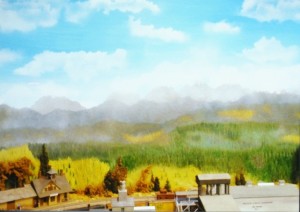
Part of the outstanding backdrop on the Cloud City & Western layout of Jack Tingstad. Note the seemingly distant hills
After each “layer” of scenery is sprayed on the backdrop (starting from the distant mountains/hills, and working closer to the viewer), Jack sprays a fine mist of white or light gray paint to sort of add some haze to the scene. It really adds some depth to the backdrop, and sort of pushes the distant mountains further away from the viewer.
Jack uses tube acrylics when painting some foreground scenery, such as trees, and remarked that “fan brushes” are absolutely a requirement for painting trees, especially evergreen trees.
Also essential is the use of reference material before you start slinging paint on your pristine blue backdrop – images on the internet, as well as calendar photos, are a great resource.
Back to clouds, Jack remarked that “there are no bad clouds” – you can’t really screw up a cloud – just look skyward at the huge variety of clouds we so frequently see in our neck of the woods!
Tom took over the stage next, and took us through all the steps necessary to complete a nicely scenicked hillside. Tom, who is famous locally because he won third place in the Model Railroader layout planning contest in October, 2012, had pre-built a small scenic base out of pink Styrofoam, 1” thick pieces glued together in several layers sloping towards the rear.
Tom is a proponent of “Ground Goop”, which is a concoction that can be troweled on to a base to add texture and fill in gaps, etc. This method has been around for decades and has proven it’s worth and popularity. The recipe is 1 cup Celluclay, 1 cup Sculptamold (both available on-line or at craft stores), 1 cup brown or tan latex paint, and 1/3 cup Elmer’s white glue (and 1 capful of Lysol to act as a mold deterrent if you are going to store unused, mixed goop for a while). It will keep, properly covered, for several days or even weeks.
Tom trowels it into place, then sprinkles non-sanded tan or brown grout over the wet goop to add texture. He follows up with a variety of ground cover, including ground up leaves from his yard, tea leaves, and commercially available products.
Planting trees in Ground Goop is easy as the goop base provides a stable material to poke holes in for tree trunks (unlike hardshell hydrocal, which is thin and brittle and doesn’t support tree trunks well).
Both Jack’s and Tom’s presentations were outstanding and I heard more than one individual say he/she was anxious to get home and try these techniques out.
Next month, on March 12, Stathi Pappas, the Chief Maintenance Officer for the Mount Rainier Scenic Railway, will be our guest clinician, talking about operations on the railroad and restoring steam locomotives. Be sure mark your calendars!
Skagit Valley/Whidbey Clinic January Report
Article and Photos by Al Carter
Clinic chairman Rich “Frenchie” Blake (nickname in recognition of his jaunty new beret) called the January 2014 Skagit Valley/Whidbey Clinic meeting to order shortly after 7:00pm. Several announcements followed:
- “Operating Day” is coming up February 22nd. Folks will have the opportunity to operate on one of five layouts (Jack Tingstad, Al Frasch, Dick Haines, Phil & Susan Gonzales, or Tom Hawkins). Rich will be sending out an e-mail to all with details.
- Rich reminded people that if they have a Sno-Isle Regional Library Card they can access a lot of publications for free, such as Model Railroader, etc.
- Rich reminded us to support Suzie, at Performance RC Hobbies in Burlington, as she always goes the extra mile to help us out and will order just about anything.
- Don’t forget the upcoming United Northwest Model Railroad Club’s annual swap meet at the Monroe Fairgrounds on February 1 and 2. The Pacific Northwest On30 Modular Layout will be set up – come and see Rich’s (and other’s) latest work.
- The Pacific Northwest Modeling Congress is coming up on March 1st in Elsie, Oregon. Some terrific modelers show up at this annual one day event, which is well worth attending. Click here for more information.
The featured clinic for the evening was “Be A Rock Star” and was a two part clinic. The first part was presented by Phil and Susan (“Janis Joplin”) Gonzales and was a hands on, make and take clinic on making cast plaster rocks. Phil and Susan provided a bunch of molds, plastic tubs, stir sticks, and some plaster, and participants got busy and mixed and poured plaster into molds. A number of participants had never actually made rock castings before this opportunity.
The second part of the clinic was presented by Jim Tartas, who has become an expert on using the Joel Bragdon rock casting system called Geodesic Foam. Joel is a geologist, artist, and sculptor so he has a great background for this business (that he has been in for well over 30 years). Jim showed slides of how he used the system to build up some enormous rock mountains on his home layout. Joel sells a huge variety of rubber molds; one that Jim used was several feet across!
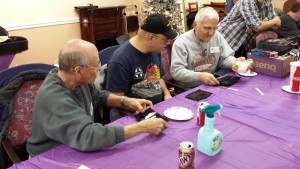 Jim discussed how he deviated somewhat from Joel’s standard process, due to Jim’s chemical sensitivities and found that Joel was quite helpful via several phone calls. The resin that Joel sells is a 2-part process that is water-based, which reduces sensitivity issues.
Jim discussed how he deviated somewhat from Joel’s standard process, due to Jim’s chemical sensitivities and found that Joel was quite helpful via several phone calls. The resin that Joel sells is a 2-part process that is water-based, which reduces sensitivity issues.
Jim also showed how he colored his castings using first dry tempera paint powders, then tempera paint washes, and the results were fantastic!
Jim finished the evening by showing a DVD that features Joel working on Tom Miller’s huge “F” scale indoor layout, which required an enormous amount of rock castings. Joel and Tom demonstrated all the steps to go through when using Joel’s system and this process certainly can cover a lot of square feet in short order! Much, much faster than using smaller, commercially available rock molds such as those available from Woodland Scenics.
I’d like to add that even if you prefer the plaster or hydrocal method of casting rocks, Joel’s rock molds are superior (and much bigger) and are easy to use. I purchased several large molds a number of years ago and they have held up well and produce some excellent rock castings.
For more information or to order Joel’s products, click here.
For the February 2014 clinic, we have a “two-fer” program lined up: Two great clinicians. First up is Tom Hawkins discussing his scenery methods, and then Jack Tingstad will talk about backdrops (this part is a reschedule from last season). And, as mentioned, earlier, don’t forget our Operating Day on February 22nd.
Our future clinic schedule includes:
- March 12, Steam Locomotives by Stathi Pappas (CMO of Mount Rainier Scenic Rwy)
- April 9, Two Views From Above featuring Roof Detailing by Al Carter and Removable Mountain Construction by Norm Myers
- May 14, Vehicle Lighting by Nick Muff
- June 11, Airbrush Painting by Rich Blake (to be held at the Gonzales residence in Oak Harbor)
Don’t forget to bring your no longer needed items for our swap mart prior to the clinic, and don’t forget that all are welcome at the pre-clinic dinner at San Remo’s Restaurant on Midway Blvd in Oak Harbor at about 5:00 pm.
December 2013 Skagit Valley/Whidbey NMRA Clinic
Al Carter / Photos By Al Frasch
Clinic Chairperson Rich Blake welcomed all to our December clinic. He gave a brief rundown of upcoming model railroad related events in the Pacific Northwest, noting that the Fourth Division’s Pacific Science Center show will be held on MLK weekend, January 18-20 2014, and volunteers are always needed to help. Check the Grab Iron for more details.
Jack Tingstad reported that his annual open house over the Thanksgiving weekend was another resounding success – he estimates several hundred visitors came by to see his Cloud City And Western railroad and donated over 1000 pounds of food to the “Gifts From The Heart” food bank in Coupeville.
Al Carter gave a brief rundown on the upcoming PNR Convention to be held June 18-21 in Tacoma, WA and encouraged folks to attend. A great “warm up” for the NMRA National Convention to be held in Portland, OR in 2015.
Ted Becker was the featured clinician for the evening, with a program titled “Everything DCC” – which was a general overview of the DCC method of operating model railroads. Ted had asked earlier for people to send him questions that he could answer to the whole group, but the response was, er, underwhelming, so instead he made up his own questions.
Among his “questions” was “What Is Wrong With Sound” (DCC sound decoders)? His answer, and this author is in agreement, is that sound decoders “out of the box” are generally too loud. When several sound equipped locos are running, they are filling the room with sound that becomes hard to distinguish. In Ted’s opinion, the decoders should be turned down so you hear the loco when it passes by you, but doesn’t overwhelm the room.
He also discussed the “keep alive” features that some DCC circuit boards are including these days (that keep the loco running when it encounters a brief dead spot, like a frog) – these keep alive features can create some programming issues. ed mentioned some work-arounds.
Ted also discussed the various ways to program a locomotive, and mentioned the new BLI Address Changer (but he hasn’t had time to review it yet), and the Sprog unit (from England). Ted then went into a brief overview of Decoder Pro, and brought it up on the computer and screen so we could all see how easy it is to use. Ted had brought a small test system with him and actually used Decoder Pro to make some changes to the loco.
Ted suggests for help using Decoder Pro, you have several options – you can peruse the JMRI pages on the web, type questions into a web search engine, download the full manual, or join a Yahoo Group on JMRI and/or DCC systems. Plenty of options are available.
As there was a little time left over, Ted gave a brief ad-libbed overview of JMRI’S Operations software and how it can be utilized to make operations orders and switch lists. For more info on the JMRI Operations Software, see: http://jmri.sourceforge.net/help/en/html/apps/PanelPro/PanelPro.shtml
The January 2014 Clinic starts the new year off with a presentation “Be A Rock Star – Make and Take Rocks” by Jim Tartas on using the Joel Bragdon Geodesic Foam/Resin method of making rocks. I’ve seen Joel Bragdon give demonstrations on this method before and it is certainly an intriguing way to produce some great looking rocks without all the mess of using plaster or hydrocal. Don’t miss this clinic!

